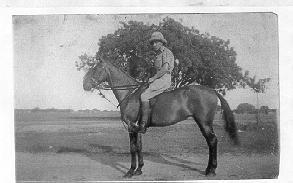



A little later the prisoners were subdued and gave up their arms. They were marched into a field and members of the 4th Kompanie 2 Abteilung of this division, under the command of Obersturmführer Fritz Knoechlein murdered approximately 100 members of the 2nd Royal Norfolk Regiment at La Paradis. Apparently after the massacre Knoechlein, who was despised by other SS officers, went around like a madman looking for other prisoners to shoot. Amazingly two British soldiers survived, hiding under a pile of bodies. One was wounded in the leg and were forced to surrender later, after hiding for three days in a nearby farm.

The scene of the mass grave shortly after the incident in the yard of Louis Creton farm in La Paradis, photographed by the owner of the farm. The grave was tended by local French people.
He was brought to trial in 1948 and was identified by Madame Castel, a French peasant women who had been interrogated by Knoechlein as to the whereabouts other British Soldiers. During the interrogation she had noticed a twitch on his face and eyes and had later at the trial had recognised him by this disability and he went to the gallows on 28th January 1949.
The bodies of the Norfolks were exhumed in 1942 by the French and re-buried in a plot behind La Paradis church. Only fifty of the bodies could be identified. After the war commonwealth headstones were added to the graves.


I would like to thank Ciaran Byrne for the pics and info on this page.Visit his site atFORCES 70 ELITE FORCES









The Miracle of Dunkirk Reconsidered
CHARLES LUTTON
Dunkirk: The Patriotic Myth by Nicholas Harmon. New York: Simon & Schuster, 1980. 271 pp. with appendices, maps, photographs, annotated bibliography, index. $12.95 ISBN: 0-671-25389-1

Forty one years ago nearly 340,000 British and French troops were evacuated from the besieged port of Dunkirk. At the time the event was portrayed by the British government and press as a kind of victory. The "Spirit of Dunkirk" became a powerful instrument to help sustain morale at home and rally support abroad. Though a number of perceptive military analysts arrived at a more sophisticated understanding of Dunkirk years ago, the war-time version of the event is still repeated, not only in popular literature, but in college texts as well.[1]
Nicholas Harmon, a British journalist and broadcaster, has written a noteworthy study of the Dunkirk episode that goes well beyond previous accounts. In preparing his major revision of Dunkirk, the author consulted Cabinet papers, war diaries, and other newly released documents that had been kept secret for over thirty years under Britain's Official Secrets Act. Harmon had anticipated retelling the familiar story in modern form. But, in light of the previously unavailable records, he found that "as I proceeded the simple truths began to slide away."
Reviewing events from the German invasion of Western Europe on 10 May 1940 to the decision of the British government to withdraw its forces from the continent, Harmon discovered that the long-held assertion that Britain was let down by her French and Belgian allies is a myth. Although the Allies outnumbered their German opponents, including a superiority in tanks,[2] Hitler's generals employed innovative tactics to subdue their more numerous enemies. On 22 May, Churchill's Cabinet decided to retire the British Expeditionary Force (BEF) from France. Anthony Eden formally ordered the commander of the BEF, General Lord Gort, to deceive his Allies about the British Army's intention to retreat. Churchill contributed to the deception by reassuring French Premier Reynaud that Britain was firmly committed to victory. Even as the British prepared to evacuate, they tried to convince the Belgians to continue to fight. The Belgians did remain on the field of battle for an additional five days, which delayed the advance of German Army Group B toward Dunkirk. As the author points out, "Far from being betrayed by their Allies, the British military commanders in France and Belgium practiced on them a methodical deception which enabled the British to get away with their rear defended."
Harmon's research disclosed that the British were responsible for crimes against both German soldiers and Allied civilians. Some British troops were supplied with dumdum bullets-lethal missiles expressly banned by the Geneva Convention on the rules of war. London issued directives to take no prisoners except when they specifically needed captive Germans for interrogation. For this reason British Tommies feared being captured because "they supposed that the enemy's orders would be the same as their own." On 27 May, ninety prisoners of the Norfolk Regiment were killed by members of the SS Totendopf Division and on 28 May over eighty men of the Warwickshire Regiment were executed by troops of the SS Adolf Hitler Regiment. These acts were committed in retaliation for the massacre of large numbers of men of the SS Totenkopf Division who had surrendered to the British.
French and Belgian civilians fared little better than the Germans at the hands of their British confederates. Looting was common and "stealing from civilians soon became official policy." British military authorities executed without trial, civilians suspected of disloyalty. In one instance, reports Harmon, the Grenadier Guards shot seventeen suspected "fifth columnists" at Helchin. The perpetrators of these war crimes were apparently not disciplined or placed on trial, as were German soldiers later charged with similar acts.
The evacuation from Dunkirk, codenamed "Operation Dynamo, " commenced on 26 May. It was originally hoped that up to 45,000 men might be rescued. The actual total came to 338,000 men.
Lord Gort was instructed not to inform his French and Belgian colleagues that the evacuation was beginning. South-east of Dunkirk the British withdrew their units, leaving seven French divisions alone to face the advancing Germans. The French fought on until their ammunition was exhausted and managed, like the Belgians, to tie down German forces that would otherwise have been available to assault the perimeter of Dunkirk.
As British and French troops retired toward Dunkirk, Admiral Sir B.H. Ramsay organized the sea lift to England. After the French government protested, a written order was issued commanding that French troops be embarked in equal numbers with the British. In practice this was not carried out. Harmon records that when Frenchmen tried to board boats on the beach, Royal Navy shore parties organized squads of soldiers with fixed bayonets to keep them back. On at least one occasion a British platoon fired on French troops attempting to embark. Only after practically all the British had escaped were efforts made to evacuate the remaining French soldiers. But when the port surrendered to the Germans on 3 June, over 40,000 French soldiers were captured.
Perhaps the most memorable aspect of the evacuation was the role played by civilians in their small boats. Harmon explains that this is just part of the myth. The British public was not informed that an evacuation was underway until 6pm on 31 May. A Small Vessels Pool, based on Sheerness, did assemble a large number of small civilian craft. But most of them were useless for evacuation work. Only on the last two days of the withdrawal did civilian volunteers play a role in rescuing an additional 26,500 men from the beaches. Their contribution, notes the author, "was gallant and distinguished; but it was not significant in terms of numbers rescued."
Harmon re-examined the on-going controversy concerning Hitler's order of 24 May, halting for two days the German advance in the direction of Dunkirk. After the war some German officers claimed that they were "shocked" when they received the order to stop their tanks at the river Aa, which permitted the French to establish a defensive line on the west side of Dunkirk. At the time, however, Panzer General Heinz Guderian visited his leading units on the approaches to Dunkirk and concluded that General Von Rundstedt had been right to order a halt and that further tank attacks across the wet land (which had been reclaimed from the sea) would have involved a useless sacrifice of some of his best troops. In his post-war memoirs and discussions with Sir Basil Liddell Hart, Guderian tried to blame Hitler for the suspension of the advance. From his discussions with Guderian and other German generals, Liddell Hart concluded that Hitler permitted the British Army to escape on purpose, hoping that this generous act would facilitate the conclusion of peace with Britain.[3]
A number of years ago it became clear that the order to stop the advance of the German Panzer units had been expected for some time. General Von Rundstedt finally issued that order on 24 May which Hitler simply confirmed.[4] The troops were allowed to rest and local repairs were carried out on the armored vehicles. When the offensive resumed on 26 May the German priorities had shifted and the focus of the attack was Paris and the heartland of the country where a large body of French troops remained. Dunkirk was regarded as a sideshow. German Air Force units were assigned to bombard Dunkirk, but the weather there was generally unsuitable for flying and during the nine days of the evacuation the Luftwaffe interfered with it only two-and-a-half days-27 May the afternoon of 29 May and on 1 June.[5]
While the author has written a solid re-appraisal of Dunkirk, he is less trustworthy when he wanders from his topic. For instance, early in his narrative Harmon repeats the old fable that pre-war German re-armament "was the motor of the country's economic recovery in the 1930's." Later on, he states that "in conspiracy with the German dictatorship, the Soviet dictatorship swallowed up Finland" (sic). A good editor should have caught this error.
Nicholas Harmon's study shows that an event which has long been celebrated as one of the greatest triumphs in British history, was, in fact, a major defeat. The evacuation of a third of a million men was a unique achievement, but a military catastrophe nonetheless. In de-mythologizing Dunkirk, he has made a contribution to our understanding of the Second World War.